Equipment Insight: Skid Steer and Compact Track Loaders
Compact track loaders and skid steer loaders continue to evolve to meet rental market needs. Experts from Case CE, Develon, Ditch Witch, Doosan Bobcat, HD Hyundai North America, JCB, John Deere, Manitou, New Holland, Kato CES, Sunward and Toro share their insights.
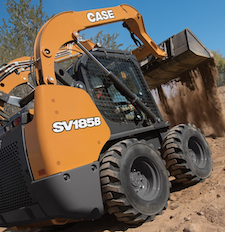 |
|
General industry trends for SSLs and CTLs appear to be driving more productive and larger platforms. They manage attachments that require increasing hydraulic horsepower to improve productivity and are used more often in production environments. |
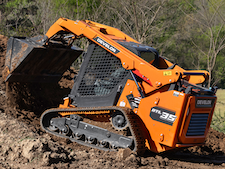 |
|
The introduction of compact track loaders in North America has spurred a trend away from traditional rubber tire skid-steer loaders, particularly within the construction, landscaping and underground utility industries. |
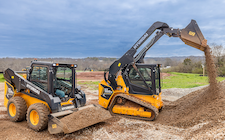 |
|
SSLs and CTLs each have distinct advantages tailored to different construction and landscaping scenarios, ensuring contractors can select the right equipment to maximize efficiency and performance on the job site. \ |
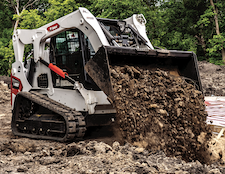 |
|
Today’s customers are looking for equipment that will improve their job site efficiency and overall work experience. Skid-steer loaders and compact track loaders are two excellent choices when it comes to landscaping, construction, forestry, snow removal and agriculture work. Selecting one piece of equipment over another often comes down to project requirements and space restrictions. |
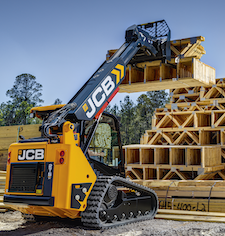 |
|
Compact track loaders offer greater tractive effort thanks to the track contact with the the ground. Conversely, wheeled machines have better compaction over the surface of the work area and can spin 360 degrees within heir own footprint; they are considered the more maneuverable of the two. |
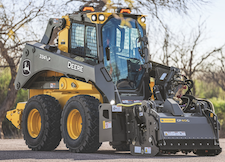 |
|
Skid steers and compact track loaders have many things in common, so the trade-offs in machine form are minimal. The decision is typically driven by the most common underfoot conditions the machine will be used in. |
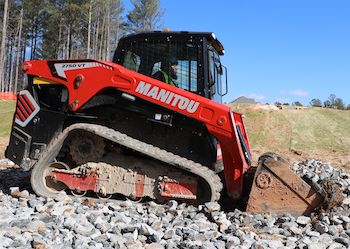 |
|
If renters are more into landscaping, earthmoving and utility businesses that regularly working in soil or finished landscapes, then CTLs are going to lead rental fleet demand. |
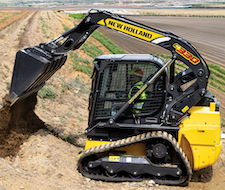 |
|
The market share of compact track loaders has been increasing, with some reports indicating that they now surpass SSLs in terms of sales by almost 3 to 1. |
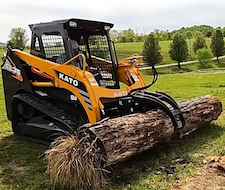 |
|
KATO: One key difference is that a compact track loader is far better at moving over uneven or difficult terrain, however, they don’t have the same level of maneuverability as a skid steer because they lack zero-radius turning capabilities. |
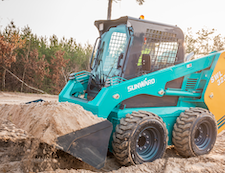 |
|
CTLs provide customers with flexibility across various terrains due to their lower ground pressure. Additionally, their stability from tracks makes them easier to operate compared to wheeled skid steers, |
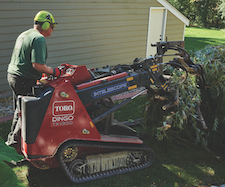 |
|
The growth of compact utility loaders is driven by several factors including improved visibility, enhanced maneuverability, quicker entry/exit of the machine, and improved operator comfort. |
 |
|
BRAD STEMPER |
Trend toward larger units
The demand for compact track loaders has steadily increased while skid steer loader demand has remained relatively flat or down on a year-over-year basis. Customers have recognized and found that CTLs simply provide greater opportunity for their jobs.
Skid steer loaders (SSLs), with their use of tires, can limit operation in poor ground conditions and may prevent operation from time to time, although they remain a little more comfortable to operate and don’t transfer bumps and jerks to the operator as much as a compact track loader (CTL). SSLs and CTLs are so similar in about all other aspects, it comes down operator preference.
CTLs increase utilization. They allow an operator earlier operation in the spring when the ground is soft. This increased utilization and productivity comes at a bit of a premium though, because the rubber tracks and the tracked undercarriage come at a premium. CTLs can cost $12,000 to $15,000 than a similar sized skid steer model.
Travel speed is also a tradeoff. Rubber-tired machines generally run up to 50 percent faster than rubber-tracked versions. This supports more productivity for machines that need to travel farther around the job site, because it speeds transport time.
Stand-on mini tracked or wheeled versions are gaining popularity. They offer operators increased ease of operation and simpler systems to control. A stand-on unit allows an operator to hop off and on the operator platform as the job dictates. An operator, often required to do various jobs on smaller projects such as landscaping or contracting work, can easily keep the machine running while doing something by hand, moving material or talking with others on the job site.
This simply and easily allows one person to do more around a job site without requiring them to crawl in and out of the traditional skid steer or compact track loader operator’s station or cab.
The trade-off though, is that these machines tend to be smaller horsepower units that can lift less than the common, higher power and greater performance skid steer and compact track loaders.
General industry trends for SSLs and CTLs appear to be driving more productive and larger platforms. They manage attachments that require increasing hydraulic horsepower to improve productivity and are used more often in production environments. This also makes them a little more cumbersome to transport. Heavier machines can mean more trailering restrictions needing like commercial driver’s licenses or larger trailers and trucks. The smaller, lighter mini track loaders like the Case TL100 track loader are easily trailered or even carried in the bed of the contractor’s truck. They provide motorized capabilities in a much smaller package.
 |
|
DYLAN FREEMAN |
Compact track loaders gaining momentum
The introduction of compact track loaders in North America has spurred a trend away from traditional rubber tire skid-steer loaders, particularly within the construction, landscaping and underground utility industries. The shift is also evident in the rental market, where CTLs are increasingly replacing skid-steer loaders.
Compact track loaders offer enhanced traction when working in soft, wet or loose ground conditions, making them popular on many construction job sites. Their tracked undercarriage coupled with high horsepower provide more pushing performance than traditional skid-steer loaders. Contractors can operate grading attachments with a compact track loader, including laser-guided systems for enhanced accuracy and productivity. This furthers the popularity of compact track loaders, particularly among concrete contractors who can use compact equipment rather than larger machines for precise work.
If rental centers are renting loaders to customers who are working on concrete or asphalt, it may be more practical for renters to choose a skid-steer loader than a compact track loader.
Skid steer loaders are generally less expensive than compact track loaders and rental centers can get a better return on their investment so long as they rent the rubber-tire machines. The challenge is many customers have become so familiar with compact track loaders that they prefer them for any construction job.
A trend in both skid-steer and compact track loaders over the past five years is the development of machines with increased horsepower and high-flow auxiliary hydraulics. These enhancements can operate attachments like forestry cutters, rotary cutters and mowers.
Additionally, more manufacturers are offering telematics fleet management systems for remote machine monitoring. Compact equipment is among the most often stolen types of construction equipment, so telematics enables owners to increase security. This can include creating a geofence for where the machine can operate, as well as limiting the hours of use. If a machine is operated outside of the approved hours, owners are alerted.
|
BRIAN KUKUK |
Stand-on units gaining popularity
While both machines yield unique advantages and applications, stand-on skid steers have seen a significant surge in popularity over the last decade. This shift has been driven by the superior visibility, compact size and expanded capabilities of stand-on skid steers.
However, both stand-on and sit-down units have their place on the job site and continue to grow in their respective industries. With increased power, a variety of attachment options and operator efficiencies, they are both excellent rental options.
The industry is seeing growth in tracked machines specifically. Over the last 10 years, tracked machines have been outpacing their tire counterparts due to their enhanced performance on challenging terrains. Rental centers and end users often face a choice between sit-down skid steers and stand-on skid steers, each offering distinct advantages and tradeoffs. Sit-down skid steers are typically larger, ranging from 74 to 100 horsepower and have greater lifting capacity. This makes them ideal for heavy-duty tasks such as loading and moving gravel or concrete for extended periods. However, their larger size and weight present transportation challenges, requiring a larger truck, trailer and a CDL, which can be a barrier for some operators.
In contrast, stand-on skid steers, with horsepower ranging from 24 to 59 horsepower, are smaller and more compact. This makes them easier to transport and more accessible to a broader range of customers, including homeowners and weekend warriors who do not need or have a CDL license. While they may have less lifting capacity, stand-on skid steers can perform similar tasks and are beneficial for jobs that require frequent on-and-off operation. Their compact size and 360-degree view make them ideal for navigating tight, confined spaces and reducing the risk of property damage.
Ditch Witch engineers design its stand-on skid steers to be compact, lightweight and versatile while prioritizing operator visibility. This helps operators work more confidently and efficiently, especially in tight spaces. Ditch Witch stand-on skid steers are also equipped with simple, intuitive controls, making them less intimidating for novice users and ideal for a variety of tasks with multiple attachments.
Recently, there has been a noticeable shift toward stand-on skid steer models, especially among landscapers, hardscapers and irrigation professionals. These users prefer stand-on skid steers for their lighter weight and reduced impact on turf, making them ideal for residential and yard work.
Contractors and weekend warriors find stand-on skid steers appealing due to their compact size and enhanced visibility, making them ideal for tasks requiring frequent on-and-off operation and navigating confined spaces. Additionally, their ability to accommodate – and transport – a variety of attachments has led to broader adoption among professionals who need to switch tasks quickly and efficiently.
On the other hand, sit-down skid steers remain the preferred choice for intensive material-moving tasks. These machines excel in heavy-duty tasks that require greater lifting capacity like moving rock and heavy materials over extended periods, making them indispensable for large-scale construction and infrastructure projects.
 |
| MIKE FITZGERALD Marketing Manager Bobcat Company |
Smarter machines better matched to the jobs at hand
Today’s customers are looking for equipment that will improve their job site efficiency and overall work experience. Skid-steer loaders and compact track loaders are two excellent choices when it comes to landscaping, construction, forestry, snow removal and agriculture work. Selecting one piece of equipment over another often comes down to project requirements and space restrictions.
Contractors should consider their site size limitations, the ground surfaces they’re working on, lifting requirements and overall versatility needed for the jobs at hand. The versatility of each machine makes them trusted workhorses on most job sites, but selecting the machine that is best suited for your project will ensure its successful completion.
Both the skid-steer loader and compact track loader markets are growing because operators and contractors want machines that provide the best return on investment. The powerful hydraulics, impressive lifting capabilities, attachment versatility and improved comfort features make both machines the preferred selection for customers who need to tackle a variety of job site challenges.
Doosan Bobcat wants its customers to have an excellent experience with any piece of equipment they rent or purchase from the Bobcat lineup. A main consideration when choosing between a skid-steer loader and compact track loader is the type of ground that operators will be working on. The tracks of the compact track loader make it a preferred choice when it comes to working on uneven ground or job sites with soft, moist earth. However, skid steer loaders present a more efficient and cost-effective approach when operating on hard surfaces.
Bobcat offers small articulated loaders and a mini track loader for work in tight spaces; both machines offer superior performance with minimal ground disturbance.
Bobcat equipment designers are always focused on developing equipment for tomorrow’s job sites. Bobcat’s MT100 mini track loader is nimble and mighty, while fitting into tight spots where the only other option used to be a wheelbarrow and a shovel. Its narrow width and minimal ground disturbance preserves the integrity of the landscape, preventing costly and time-consuming ground repairs.
Another growing trend is the electrification of equipment. Bobcat unveiled the world’s first all-electric compact loaders with the T7X compact track loader and S7X skid-steer loader. These all-electric options deliver the benefits of electric power and zero emissions with increased performance.
Today’s equipment is also showcasing incredible advances in innovative offerings like Bobcat’s MaxControl remote-operating system which allows customers to control their Bobcat loader and attachments outside the cab, effectively allowing operators to complete two-person jobs with one person.
Bobcat Machine IQ is another innovation that allows operators to monitor and manage connected machines from virtually anywhere. This helps owners monitor their machine’s health, enhancing maintenance, security and performance.
 |
|
DAVID SPOONER |
Compact track loaders gain attention and market share
In 2023, compact track loaders outsold skid-steer loaders at a rate of nearly 4 to 1. This noteworthy trend marks a significant departure from previous industry standards, reflecting evolving preferences among contractors.
The dominance of CTLs over SSLs can be attributed to several key factors. Equipped with rubber tracks instead of wheels, CTLs offer enhanced traction and stability, making them ideal for rough, muddy, or snowy conditions where SSLs might struggle to maneuver.
CTLs are increasingly perceived as versatile machines suitable for a wider range of applications. Originally favored for heavy-duty tasks such as excavating and hauling, CTLs have now proven their mettle across diverse sectors including landscaping, agriculture and residential construction. Their ability to operate with minimal ground disturbance further adds to their appeal.
While SSLs still retain a loyal following in specific niches, current market dynamics underscore a preference for CTLs among end users seeking robust performance, versatility and operational efficiency.
SSLs and CTLs each have distinct advantages tailored to different construction and landscaping scenarios, ensuring contractors can select the right equipment to maximize efficiency and performance on the job site. SSLs and CTLs are highly versatile machines capable of performing a wide range of tasks, including loading, digging, grading and hauling. SSLs are known for their exceptional maneuverability in tight spaces and on smooth surfaces, making them ideal for indoor construction projects and areas with finished landscaping.
In contrast, CTLs excel on rough, uneven terrain and soft ground conditions due to their superior traction and stability. This makes CTLs suitable for outdoor construction sites, agricultural applications and landscaping on varied terrain.
SSLs and CTLs are designed for high productivity, with quick attachment changes and efficient hydraulic systems that allow operators to tackle multiple tasks swiftly.
Initial purchase costs and operational expenses can vary between SSLs and CTLs based on specific models, usage patterns and maintenance needs, allowing buyers to choose based on their budget and project requirements.
The choice between SSLs and CTLs often depends on individual project needs, terrain conditions and operator preferences, rather than a strict trade-off in capabilities.
Stand up compact tool loaders are certainly gaining in popularity due to maneuverability, entry cost and the ease of accessing the operators station, however, there are many applications where the operator benefits from a sit-down version that can deliver superior operator comfort for long tasks while providing better protection from extreme temperatures, dust, flying debris or falling objects.
Like their sit-down cousins, current models of stand-up compact track loaders feature advanced telematics for remote monitoring, enhancing operational efficiency and minimizing downtime crucial for maximizing construction project uptime.
Stand-up compact track loaders excel in confined spaces and urban settings due to their compact size and enhanced visibility. Technological upgrades, including joystick controls and integrated telematics, improve efficiency and simplify maintenance. Analysts predict rising demand for these versatile machines across various applications, enhancing operational efficiency and minimizing downtime crucial for maximizing construction project uptime.
Stand-up compact track loaders excel in confined spaces and urban settings due to their compact size and enhanced visibility. Technological upgrades, including joystick controls and integrated telematics, improve efficiency and simplify maintenance. Analysts predict rising demand for these versatile machines across various applications.
 |
|
LEE TICE |
Larger machines, more power expand uses
CTLs will give users a higher rated operating capacity thanks to their lower center of gravity and heavier undercarriage compared to SSLs. CTLs have a tipping capacity of 35 percent of operating capacity whereas an SSL will be rated at 50 percent of operating capacity. The CTLs offer greater tractive effort thanks to the track contact with the the ground. Conversely, wheeled machines have better compaction over the surface of the work area and can spin 360 degrees within their own footprint; they are considered the more maneuverable of the two.
Over the last few years, CTLs and SSLs are getting larger, even getting into the 15,000- to 16,000-pound range. Tracked machines are becoming the majority vs. wheeled machines and there is a trend toward higher hydraulic flows and pressures to operate the bigger attachments such as mulching heads, cold planers and milling attachments.
CTLs used to be primarily tool carriers but they’ve transitioned into more of a multi-purpose machine and in some cases, can replace multiple machines on the job site. Operationally, sit-down CTLs and SSLs are better when users are running for long periods of time when compared with stand-on models. A stand-on machine is going to wear the operator out if he or she is on it for many hours during the day. They are better for quick work and intermittent operation. SSLs and CTLs can move much more material in a shorter period and carry much heavier loads. They also offer the operator the protection of a ROPS or canopy overhead. The range of attachments that can be used with a CTL or SSL is much larger as well.
CTLs and SSLs are different machines for different applications. The tracks and undercarriage of a CTL make them a slightly more expensive machine, but in many applications that cost is balanced by the fact they’re going to be more productive.
 |
|
EMILY PAGURA |
Consider track and tire options
Generally, the market has been trending toward CTLs over skid steer loaders for the last few years. Compact track loaders are typically heavier than skid steers, but still have excellent maneuverability and transportability vs. other construction machinery.
It is important to consider several items when trying to best determine whether a CTL or skid steer is the best fit for your needs. The typical ground conditions of most of the renter’s job sites is an important aspect to consider. If users will be lifting heavy objects or doing clearing or demo work, a CTL is a great option as they typically have higher lifting capacity and offer more pushing power than skid steers. For working on job sites that include soft ground conditions or steep terrain, CTLs are also better suited.
If an operator needs increased mobility and is working on hardscapes, the style of tires on a skid steer loader will make a difference on the job.
Skid steers and compact track loaders have many things in common, so the trade-offs in machine form are minimal. The decision is typically driven by the most common underfoot conditions the machine will encounter. Compact track loaders are heavier but have more surface on the ground than skid steers, so they are typically found in soft conditions where flotation is critical, or applications where low ground pressure is a priority. On the other hand, hard-packed dirt or paved surfaces are better suited to wheeled machines, which have higher ground pressure, but are lighter and easier to maintain.
One way to address the tradeoffs between the two types is by providing a variety of options when it comes to tracks and tires. Tread patterns vary widely, and John Deere offers a wide selection of patterns and price points in both tires and tracks. A John Deere dealer can help identify the best options for any application.
 |
| NATHAN RYAN Global Product Manager Manitou Group |
Strategic focus needed for model selection
There will always be a market for sit-down skid steers and CTLs. Simply from a size, scale and capacity standpoint, there are things that more conventional skid steers and CTLs can do that stand-on units just can’t do.
Traditional sit-down skid steers and CTLs also do a better job of keeping operators safe and removed from the conditions of the job site. They can also run bigger attachments, and the control interfaces of traditional skid steers and CTLs are protected from the elements, whereas stand-on units’ controls are fully exposed to the environment.
Comparing traditional skid steers and CTLs, we continue to see greater demand for the rubber-tracked loaders for all the reasons they have dominated the market for a decade now: lower ground pressure, greater stability and operator confidence, and increased operating capacities in some cases. However, skid steers remain popular in the rental market because of their lower purchase price relative to CTLs, and the interchangeability of attachments between both styles of machines. With the continued strength of rental demand, people in need of the machine will gladly rent a skid steer if a CTL is unavailable.
The operator experience and performance is quite similar between skid steers and compact track loaders, so the real difference comes down to initial purchase price and the type of work the most frequent renters do. For instance, if the bulk of rental business is road construction or industrial work where renters are operating most of the time on concrete or improved surfaces, then a skid steer is going to be the tool of choice. If renters are more into landscaping, earthmoving and utility businesses that regularly working in soil or finished landscapes, then CTLs are going to lead rental fleet demand.
It comes down to the increased purchase price of a CTL compared to a skid steer. Some of that can be passed along in rental rates, but the most strategic focus should be on lowering that total cost of ownership for the rental business. Manitou/Gehl models do that through exclusive technologies like the Idealtrax auto-tensioning system that helps extend track life, and also through extremely simple daily service access points and easy-to-use telematics programs.
Rental businesses need to keep in mind the full life cycle of the machine. CTLs cost more upfront, but if maintained properly over the course of its work life while in the rental fleet, it will earn more on resale than a skid steer would bring. The cost of the tradeoff between the two types of units is significantly lessened when this is factored into the equation.
In a market where simpler, easy to use equipment has always been preferred, rental businesses are starting to invest in more fully featured equipment with a focus on the resale value and retained value of that machine. They’re not necessarily equipping machines with high-flow hydraulics across their fleet, but they’re willing to invest in cab comfort and operator interface improvements that ultimately increase the long-term value of the machine. That demand for more sophisticated units is being reciprocated from renters: renters who are concerned about employee satisfaction want to rent equipment that focuses on comfort and ease of use.
We’re also seeing more efforts to lower the total cost of ownership on equipment being placed into rental operations. This includes actions such as using non-pneumatic tires on machines placed into rental fleets to prevent things like downtime and tire replacement. Integrated telematics software also helps rental businesses better manage their equipment fleets, understand utilization and ensure optimal rental availability.
Attachments for these machines are an important part of the business equation. Going into an election year, there’s great uncertainty. People are renting more attachments instead of buying them, especially if they are not a high-use attachment for them. Not only can you rent attachments to people who own their own equipment, but they increase the rentability of the skid steers and CTLs in the rental fleet as it offers customers a greater range of capabilities and reasons to rent.
 |
|
DAN KAKAREKA |
Versatility and performance driving compact track loader growth
Skid steer loaders and compact track loaders are popular pieces of construction equipment, but their demand and market share can vary based on several factors:
Growth in demand: CTLs have seen a significant increase in demand over recent years. This growth is driven by their versatility, lower ground pressure and better traction on soft, muddy or uneven terrain. They are also favored for their ability to work in adverse weather conditions.
While still popular, SSLs have experienced a slower growth rate compared to CTLs. They are generally more suitable for hard, flat surfaces and are often used in applications such as landscaping, roadwork and construction sites with solid ground conditions.
Despite the growing popularity of CTLs, SSLs maintain a strong presence in the market. They are generally less expensive than CTLs and can be more cost-effective for certain applications.
In regions with softer, wetter or more variable terrain, CTLs tend to be more popular. In urban areas or regions with predominantly hard surfaces, SSLs might still hold a competitive edge due to their maneuverability and lower cost.
CTLs generally have higher upfront costs and maintenance expenses compared to SSLs. However, their durability and performance benefits can justify the investment for many operators. The choice between a SSL and a CTL often comes down to specific job needs. SSLs offer a lower initial investment, easier maintenance and high versatility, making them a staple in rental fleets. However, CTLs can command higher rental rates and meet the demand for more challenging projects, despite their higher initial and maintenance costs. The choice often boils down to the specific requirements of the job and the renter’s budget constraints.
New Holland strives to offer a diverse product offering, providing a range of SSLs and CTLs with varying features and price points to cater to different budget levels. This allows customers to choose machines that fit their financial constraints without sacrificing essential features. Flexible financing solutions can make purchasing equipment more affordable for both rental centers and end users.
There are many technological advances in the SSL/CTL market. Increasing use of telematics systems and IoT integration allows for real-time data collection and remote diagnostics, improving efficiency and reducing downtime. Development of semi-autonomous and fully autonomous features, such as automated grading systems and obstacle detection, enhance productivity and safety. Features like air-conditioned cabs, adjustable seats and joystick controls are becoming standard and the development of more specialized attachments increase the versatility of SSLs and CTLs.
Stand-up units are gaining traction in the market, especially for applications requiring frequent entry and exit from the machine. More manufacturers are introducing stand-up models to meet the rising demand.
New Holland industry watchers have yet to see stand-on units being purchased over sit-down units. They appear to be more of an entry-level unit for a landscaper whose business is growing or an addition to a fleet for its unique performance advantages.
 |
|
Charles Baldwin |
Technology driving more advanced models
The market over the last decade has shifted heavily toward the compact track loader. CTLs can access more types of ground conditions and if renters are in an environment where they don’t want to damage the ground, the advantage of the lower-pressure tracks will be attractive to them.
Compact track loaders are roughly the same size as a skid steer and can do the same functions. One key difference is that a compact track loader is far better at moving over uneven or difficult terrain, however, they don’t have the same level of maneuverability as a skid steer because they lack zero-radius turning capabilities.
To decide which type is best for your operation, look at the cost of ownership. Skid steers typically have a lower cost of ownership over the life of the machine, starting with upfront cost, however, a SSL sacrifices versatility in a variety of applications and in turn, who is interested in renting it. The best way to address those concerns is to make sure units can accommodate the needs of both parties.
Technological advances in SSLs and CTLs are creating a more operator friendly machine and environment. This technology includes advanced telematics and ground control assistance along with smarter, more user-friendly attachments. This allows for more enhanced performance, decrease in equipment wear and tear and less labor needed over the life of the machine.
 |
| SENGHEE BAIK Product Marketing and Management Specialist Sunward America |
Compact track loaders can appeal to cost-conscious buyers
Compact track loaders have gained significant ground in recent years. In 2020, financed sales saw a split of 78 percent CTLs to 22 percent skid steers. These numbers highlight the remarkable shift in demand toward CTLs.
CTLs are turf-friendly because they have low ground pressure due to their rubber tracks. They are also heavier, providing better pushing power and lifting capacity. Their long tracks offer superior traction and stability, especially on slopes. CTLs deliver a smoother ride and better bucket material retention while traveling. However, this comes at a price: CTLs are typically up to 20 percent more expensive than skid steers.
Skid steers remain popular, especially where surfaces are hard and abrasive such as paved areas. Skid steers are more affordable upfront and have lower maintenance costs.
As a manufacturer, addressing concerns involves educating buyers about the long-term benefits of CTLs, emphasizing their stability, versatility and all-weather capabilities.
While CTLs offer advantages like stability, traction, and versatility, skid steers appeal to cost-conscious buyers and specific applications. Despite being slightly more expensive and having higher maintenance costs, CTLs provide customers with flexibility across various terrains due to their lower ground pressure. Additionally, their stability from tracks makes them easier to operate compared to wheeled skid steers.
 |
| SAM DANDO Senior Marketing Manager Toro |
Stand-up units growing their niche
Compact utility loaders (CULs) have a stand-on platform for the operator, which allows for better visibility and makes it easy for the operator to get on and off the machine quickly. Demand for stand-on CULs has increased in recent years for interior construction/demolition, landscaping, tree care and the rental industry.
Overall, the Toro team is seeing more demand for smaller, more agile machines for working in tight spaces. That trend favors stand-on over sit-down machines due to their increased visibility and maneuverability.
The line between skid steers and compact utility loaders has been blurring for years. Historically, CULs were reserved for smaller-scale construction and landscaping projects due to their lower operating capacity than skid steers. Now, CULs like the Toro Dingo TXL 2000 can lift more than 2,000 pounds, which is a rated operating capacity that exceeds the capacity of some entry-level skid steers.
With equal lifting capacities, rental centers will need to look at more job-specific features when deciding to purchase new machines for their fleet.
Many popular skid steers have a cab, which can offer added protection from debris as well as air conditioning and heat for added comfort, but the cab often obstructs the operator’s view, which could be dangerous. Stand-on models allow the operator to have unrestricted visibility of the machine and its surroundings and allow the operator to easily enter and exit the machine.
Many CUL models can pass through a standard 36-inch gate or doorway to access areas where space is limited. This also means less space in the rental yard and on trailers used to transport them; the smaller size of CULs also allows for greater maneuverability; many models have a zero-turn radius.
Rental centers need to consider the difference in cost factors such as capital investment, maintenance, transport and warehousing and each is historically lower for CULs over skid steers. The wide variety of operating capacities, track or wheel configurations, power types and radial or vertical lift options allows each customer to find the best tool for their needs.
Rental companies have been among the first major buyers of electric equipment. The lower maintenance requirements and ability to put rental units to work more hours per day make these machines very appealing investments.
Electric construction equipment shines when used indoors where emissions, noise and active job sites are major concerns. The Toro eDingo 500 makes light work of interior demolition, urban renovations and any job that would traditionally rely heavily on manual labor.
-30-
This article originally appeared in the September-October 2024 issue of Pro Contractor Rentals magazine. ©2024 Urbain Communications LLC. All reproduction right reserved.








